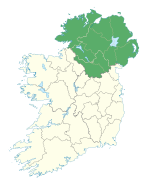Slieve Beagh
| Slieve Beagh | |
|---|---|
 Bragan Penal Cross. | |
| Highest point | |
| Elevation | 380 m (1,250 ft)[1] |
| Prominence | 285 m (935 ft)[1] |
| Listing | County Top (Monaghan), Marilyn |
| Coordinates | 54°19′08″N 7°15′11″W / 54.319°N 7.253°W |
| Naming | |
| English translation | mountain of birch |
| Language of name | Irish |
| Geography | |
| Location | County Monaghan, County Fermanagh, County Tyrone |
| Parent range | Fermanagh/Tyrone Mountains |
| OSI/OSNI grid | H523436 |
| Official name | Slieve Beagh |
| Designated | 28 July 2000 |
| Reference no. | 1035[2] |
Slieve Beagh or Sliabh Beagh (Irish: Sliabh Beatha)[3] is a mountainous area straddling the border between County Monaghan in the Republic of Ireland and County Fermanagh and County Tyrone in Northern Ireland. A point just east of its summit is the highest point in Monaghan; however the true summit is on the Fermanagh-Tyrone border.[1] The point where the three counties meet, is referred to as the "Three County Hollow".[1]
Name
The original Irish name for the area, Sliabh Beatha, has been anglicized as Slieve Beagh or half-anglicized Sliabh Beagh. According to Irish mythology, the name refers to the mythological figure Bith, who was buried in a cairn on top of the mountain.[4] Although the summit is in fact marked by a cairn, called Doocarn, it is likely that the name's original meaning is "mountain of birch".[4] In County Monaghan, the locals typically refer to the Slieve Beagh as the "Bragan Mountains", taking the name from a townland within the Slieve Beagh.[1]
Geography
Slieve Beagh has many low, smooth summits. The highest is at 380 metres (1,250 ft) and lies just inside County Fermanagh. The area is mainly blanket bog, with many small lakes and streams throughout. In Northern Ireland, much of Slieve Beagh has been designated as a Special Area of Conservation.[1]
Tourism
The Sliabh Beagh Way is a 25-mile walk starting at St Patrick's Chair and Well in County Tyrone, passing through County Monaghan and ending at Donagh in southeast Fermanagh. There are a further 31 loop walks throughout the Sliabh Beagh ranging from 2.5 miles to 12 miles.
Ramsar site
The Slieve Beagh Ramsar site (wetlands of international importance designated under the Ramsar Convention), is 1884.68 hectares in area, at latitude 54 20 53 N and longitude 07 11 38 W. It was designated a Ramsar site on 14 December 1999. The Ramsar site boundary coincides entirely with that of the Slieve Beagh Area of Special Scientific Interest and the Slieve Beagh Special Area of Conservation. The site qualified under Criterion 1 of the Ramsar Convention because it is a large and relatively intact example of a blanket bog and one of the best examples of this habitat in the United Kingdom. It also contains nationally important examples of transitional and alkaline fen and oligotrophic/mesotrophic lakes.[5]
The peatland features include occasional well developed hummock and lawn complexes, a few small pool complexes, as well as soakaways and flushes. Vegetation is characterized by sphagnum mosses and ericoid dwarf-shrubs. The peatland flora includes a number of rare and unusual species including cowberry and the mosses Sphagnum fuscum and Sphagnum imbricatum. There are several upland, base-poor lakes occur with aquatic mosses. The floating and marginal vegetation associated with these water bodies tends to be sparse and restricted, and consists of a scattered swamp and poor acid fen fringe. The area supports a breeding population of red grouse, as well as Eurasian golden plover and hen harrier.[5]
The upland lakes support a species-poor but notable upland insect fauna. The water beetle (Agabus arcticus) and the water bug (Callicorixa wollastoni) are common in the lakes and pools and the concentration of both species is the greatest recorded in Northern Ireland. The most notable species are found in the highest lake, Lough Sallagh, where the rare upland beetle Potamonectes griseostriatus and corixid Glaenocorisa propinqua are found.[6]
See also
- Cuilcagh
- Lists of mountains in Ireland
- List of Irish counties by highest point
- List of mountains of the British Isles by height
- List of Marilyns in the British Isles
References
- ^ a b c d e f "Sliabh Beagh". MountainViews. Ordnance Survey Ireland. Retrieved 2 June 2019.
- ^ "Slieve Beagh". Ramsar Sites Information Service. Retrieved 25 April 2018.
- ^ Placenames Database of Ireland: Slieve Beagh/Sliabh Beatha
- ^ a b Tempan, Paul. Irish Hill and Mountain Names. MountainViews.ie.
- ^ a b "Designated and Proposed Ramsar sites in Northern Ireland" (PDF). Joint Nature Conservation Committee. Retrieved 7 July 2008.
- ^ "Slieve Beagh Ramsar site". NI Environment Agency. Retrieved 7 July 2008.





